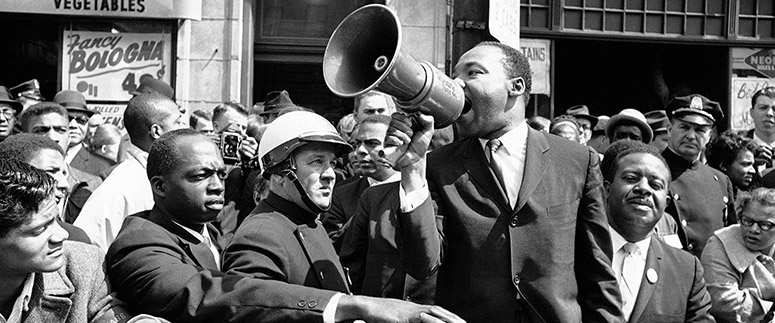THE NATION CLASSROOM
American History as It Happened
RACE RELATIONS and CIVIL RIGHTS
MODULE SIX: 1945-1965
MODEL ANSWERS
STUDENT PRACTICE ACTIVITY THREE
DBQ Essay
DBQ: Was the overall strategy of the civil-rights movement in the 1950s and early 1960s successful? Describe at least four tactics that civil-rights leaders deployed during the period and evaluate their contributions to the movement’s effectiveness.
Based on the question and the documents, students might come up with a thesis along these lines:
THESIS: The overall strategy of the civil-rights movement in the 1950s and early 1960s succeeded by bringing national attention to injustices suffered by African Americans and by taking steps that forced change to those injustices.
EXAMPLES of supporting arguments that could be derived from documents:
Document One/Dickerson: Movement lawyers presented lawsuits that demonstrated the unequal ways justice was applied under similar circumstances, demonstrating bias against African Americans.
Document Two/Freedman: Civil-rights lawyers won a crucial court case (Brown v. Board of Education), but the ultimate effectiveness of that decision depended on the plan developed for its execution.
Document Three/Nation editorial: Civil-rights leaders used numerous tactics to pressure the Montgomery, Alabama, bus service to change its seating practices. Rather than attack its segregation policy overall, they asked for first-come, first-served seating and used a variety of other tactics to reduce the bus service’s business until it did change those practices.
Document Four/Martinson: Freedom riders at first were used to push for enforcement of federal laws. In this period, they were part of a strategy of civil disobedience that caused southern jails to overflow.
Document Five/Lynd: As part of their electoral strategy, civil-rights leaders worked to register African-American voters.
Document Six/King: Dr. King discusses how thousands of actions and demonstrations asserted the power of the African-American movement, and stresses that “easy compromises” will no longer be accepted as obstacles to achieving civil rights.
Document Seven/Wille: Leaders brought civil-rights demonstrations and demands into northern cities to extend the movement for improved situations beyond southern states.
Here are examples from the documents that a student might offer that would address the question:
- Civil-rights leaders used court cases to challenge the constitutionality of segregation (documents 1, 2)
- Leaders organized protests that garnered national interest (3, 4, 5, 6, 7)
- Movement leaders promoted civil disobedience to demand change (4, 6, 7)
- Leaders used economic power to force change (3)
- Movement leaders harnessed voter power to improve the odds of political change (5)
ANSWER CHECKLIST
The specifics above will help you determine if students have responded to the DBQ with appropriate information. In addition, the College Board offers a list of characteristics that define an excellent response to a DBQ prompt.
According to the College Board, excellent DBQ essays should do all the following:
- Contain an evaluative thesis that establishes the student’s argument and responds to the question. The thesis must consist of one or more sentences located in one place, in either the introduction or the conclusion. Neither the introduction nor the conclusion is necessarily limited to a single paragraph.
- Describe a broader historical context immediately relevant to the question that relates the topic of the question to historical events, developments, or processes that occur before, during, or after the time frame of the question. This description should consist of more than merely a phrase or a reference.
- Explain how at least one additional piece of specific historical evidence, beyond those found in the documents, relates to an argument about the question. (This example must be different from the evidence used to earn the point for contextualization.) This explanation should consist of more than merely a phrase or a reference.
- Use historical reasoning to explain relationships among the pieces of evidence provided in the response and how they corroborate, qualify, or modify the argument made in the thesis that addresses the entirety of the question. In addition, a good response should utilize the content of at least six documents to support an argument about the question.
- For each of at least four of the documents, explain how the document’s point of
view, purpose, historical situation, and/or audience is relevant to the argument.
For more guidance about evaluating responses to a DBQ essay, download this PDF, which includes scoring guidelines.
https://secure-media.collegeboard.org/digitalServices/pdf/ap/apcentral/ap17-us-history-q1dbq.pdf

